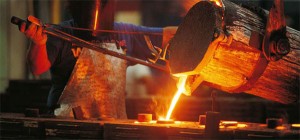
Cast iron was first invented in China and its earliest uses were for weapons, including cannon and shot
Cast iron was first invented in China and its earliest uses were for weapons, including cannon and shot. Henry VIII initiated the casting of cannon in England and, subsequently, these British blast furnaces diversified firstly into the production of cooking pots and then, in the Georgian and Victoria eras, into everything from fencing to cart wheels and from fireplaces and to kitchen ranges. Part of the reason for this was that the UK had plentiful and cheap supplies of both coal and iron ore, as well as water, to power the many innovations of the Industrial Revolution.

In continental Europe, however, with its larger areas of forest, wood burning was more prevalent for heating. Here, in order to make more efficient use of logs, enclosed stoves developed alongside open fireplaces. The British were made more aware of the idea of enclosed wood burning stoves by Dutch and German communities in the ‘New World’, where coal had yet to be discovered. Indeed, Benjamin Franklin patented a cast iron stove with folding doors in 1712 and versions of that very model are still being produced in the 21st Century!
During Queen Victoria’s reign, cast iron insert fireplaces, so called because they had built-in fire backs and were designed to be inserted into chimney openings measuring 36”w x 36”h (915 x 915mm) became the norm in many town houses and the growing numbers of suburban ‘villas’. In appearance, these were either completely cast (with or without hobs) or cast with slots for decorative tiles. The former were generally the earlier designs whilst those incorporating vertical ceramic tile panels became particularly fashionable from the 1880s onwards.
Today, cast iron still remains the material of choice for the premium quality wood burning and multi fuel stoves in Stovax’s Huntingdon range as well as reproduction Victorian Fireplaces in the Classic Fireplaces range. This is not only because of the way cast iron diffuses warmth giving maximum radiant heat over a period of time but also due to the fact that it can be molded into designs of with a wealth of intricate and elegant detail.
Furthermore, in an age of concern for the environment, cast iron can also be seen as a good example of recycling, with up to 50% of the material now being scrap iron derived from other iron products.
Sign up to our newsletter and receive the latest news and updates, including product launches, offers and promotions, exclusive giveaways and competitions, as well as seasonal tips and advice.
Subscribe Now!
Hi I have a medium Franklin that was gas then converted it to multi could you tell me how much it is to convert back to gas
Thank you for your enquiry. The Regency stove range has now been discontinued in both gas and solid fuel versions so we are unable to answer this question. Please visit your local retailer who will be able to help. They can also demonstrate a variety of Gazco gas stoves, which would make a great alternative.
My soot door, cast iron ovalish shaped, has cracked and needs replacing. The flue runs from a Stovax Severn wood burner.
Can you please advise how I can get a replacement
Good Afternoon Karen, thank you for taking the time to send us a message. If you are looking to replace anything, it can be found on our http://www.stovaxspares.com/ page. I hope this helps!
Kind Regards, Darcy.
Hello, I am trying to get hold of a large Stovax Regency stove. Do you know of anywhere which may have on in stock?
Hi Fiona, thanks for your message. We haven’t been producing Regency stoves for quite some time, but if you’re after a traditional wood burning stove, we have plenty of nice alternatives available and you can have a look at the current range here: https://www.stovax.com/products/stoves/traditional/wood-stoves-multi-fuel-stoves/
Best wishes, Chris
Any chance of getting a Stovax stove here in the far-flung colonies – preferably somewhere not too far from San Diego, California?
Hi Peter, thanks for your message. We currently only sell our electric products in the US and Canada via our sister company, Regency Fire: https://regency-fire.com
Many thanks, Chris
Hi I’m
After the bean pot and arm and I have the barbq grill just not the arm can I get these from you please
Hi Helen, thanks for your commment. This isn’t something we produce unfortunately, however your local fireplace retailer may be able to help you find one.
Best wishes, Chris